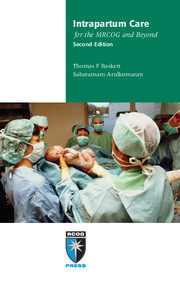Book contents
- Frontmatter
- Contents
- Preface
- Abbreviations
- 1 Improving intrapartum care
- 2 First stage of labour
- 3 Second stage of labour
- 4 Fetal surveillance in labour
- 5 Third stage of labour
- 6 Lower genital tract trauma
- 7 Induction of labour
- 8 Preterm labour and prelabour rupture of membranes
- 9 Assisted vaginal delivery
- 10 Shoulder dystocia
- 11 Breech vaginal delivery
- 12 Twin and triplet delivery
- 13 Caesarean section
- 14 Vaginal birth after caesarean section
- 15 Uterine rupture
- 16 Emergency obstetric hysterectomy
- 17 Cord prolapse
- 18 Antepartum haemorrhage
- 19 Postpartum haemorrhage
- 20 Acute uterine inversion
- 21 Amniotic fluid embolism
- 22 Disseminated intravascular coagulation
- 23 Acute tocolysis
- 24 Severe pre-eclampsia and eclampsia
- 25 Neonatal resuscitation
- 26 Perinatal loss: management of late fetal death and stillbirth
- Index
26 - Perinatal loss: management of late fetal death and stillbirth
Published online by Cambridge University Press: 05 July 2014
- Frontmatter
- Contents
- Preface
- Abbreviations
- 1 Improving intrapartum care
- 2 First stage of labour
- 3 Second stage of labour
- 4 Fetal surveillance in labour
- 5 Third stage of labour
- 6 Lower genital tract trauma
- 7 Induction of labour
- 8 Preterm labour and prelabour rupture of membranes
- 9 Assisted vaginal delivery
- 10 Shoulder dystocia
- 11 Breech vaginal delivery
- 12 Twin and triplet delivery
- 13 Caesarean section
- 14 Vaginal birth after caesarean section
- 15 Uterine rupture
- 16 Emergency obstetric hysterectomy
- 17 Cord prolapse
- 18 Antepartum haemorrhage
- 19 Postpartum haemorrhage
- 20 Acute uterine inversion
- 21 Amniotic fluid embolism
- 22 Disseminated intravascular coagulation
- 23 Acute tocolysis
- 24 Severe pre-eclampsia and eclampsia
- 25 Neonatal resuscitation
- 26 Perinatal loss: management of late fetal death and stillbirth
- Index
Summary
Stillbirth is a common adverse pregnancy outcome, affecting 1/200 pregnancies. It often exerts profound emotional and psychological effects on parents, their relatives and friends. In the UK, stillbirth is defined as a baby delivered with no signs of life that is known to have completed at least 24 weeks of gestation. This definition is based on the fact that babies that reach this gestational age are usually viable. In the USA, where the gestational age threshold for stillbirth is lower (20 weeks if the gestational age is known, or weight at least 350 g if the gestational age is unknown), the incidence is 1/160 pregnancies, although this definition is not adopted by all states of the USA. The 350 g cut-off is the 50th centile for fetal weight at 20 weeks of gestation. The Australian definition specifies that fetal death is termed a stillbirth after 20 weeks of gestation or if the baby weighs more than 400 g. The World Health Organization defines stillbirths as fetal deaths in babies weighing 500 g or more or at a gestational age of 22 weeks or more. This definition applies to stillbirth figures from 1995 on wards. The term fetal death applies to babies with no signs of life in utero.
The overall stillbirth rate in the UK is 5.2/1000 total births, while the adjusted rate is 3.9/1000, with a regional variation ranging from 3.1 to 4.6/1000. These rates have remained largely static in the first decade of the 21st century despite improvements in perinatal care, prompting suggestions that rising average maternal age and obesity rates may be underlying causes of the lack of improvement. On the other hand, the stillbirth rate in the USA fell from 7.5/1000 births in 1990 to 6.2/1000 births in 2004.
- Type
- Chapter
- Information
- Intrapartum Care for the MRCOG and Beyond , pp. 273 - 286Publisher: Cambridge University PressPrint publication year: 2011



